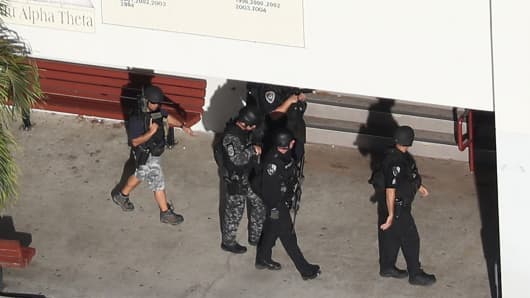Thankfully, we have a few bipartisan examples in relatively recent history that prove these tactics work.
President Bill Clinton made curbing crime and specifically slowing gun violence a funding priority in his first term. More importantly, he knew where the money needed to go to get that done. In October, 1994 he kicked off a $200 million effort to put 100,000 more police on the streets.
Even though the Democrats enjoyed controlling majorities in both houses of Congress at the time, Clinton made a successful effort to get a good number of Republicans to support the added funding for more cops.
The usual suspects in politics and academia immediately began debating the pros and cons of this and other Clinton policies to boost policing and that debate rages on. But the results really speak for themselves. Violent crime fell, especially in major U.S. cities. Bipartisan anti-crime efforts worked, period.
President George W. Bush took the ball from Clinton and ran with it even further. Under Bush, the FBI got a significant funding increase and a serious new focus to find and prosecute gun criminals. In 2003, the Department of Justice brought charges against more than 13,000 offenders for Federal firearms crimes, still the highest annual figure on record.
The result? Violent crime fell even more during the Bush years, even when compared with the already falling crime numbers under Clinton.
But then prosecutions of gun-using criminals fell during the Obama years, and so did federal law enforcement's focus on gun crimes overall. Perhaps that was because of Obama's shifting priorities. Perhaps it was because after the Republicans took control of the House of Representatives in 2010, they made it clear they wouldn't support increased spending. But either way, a successful focus on reducing the number of guns on the street has been greatly cut back.
Don't get too bogged down in whom to blame for this. There's plenty of blame to go around. The key thing to remember is that more money and more vigilant cops is what it takes from the government to slow crime no matter which party controls the White House and Congress.
Now let's talk about how this relates to school shootings and this most recent atrocity in Florida.
Reports say that the alleged shooter Nikolas Cruz legally bought at least one gun likely used in the incident Wednesday. It's not clear whether funding for an increased crackdown on illegal gun sales alone would have stopped this from happening.
But that does not mean adding and enhancing law enforcement isn't the best and most viable answer. It turns out the police in Florida have long been asking for more money to protect schools. Yet the total funding allocated each year for the state's Safe Schools project has remained frozen at $64.4 million for the past seven years. That's also significantly down from the $75.6 million annual budget it had in 2008.
This is where the political realities start to come into the picture. Passing and enforcing widespread gun bans or confiscation programs still seem like a political long shot. But getting a critical mass of voters to support federal grants to states and local police departments to improve school safety is a slam dunk by comparison.
Another aspect of the Clinton policing policy is very relevant. Clinton didn't just get the funding for more cops, but also to implement community policing programs where cops interacted much more closely with their local neighborhoods and achieved a better relationship with them.
With that came the added benefit of recognizing threats in those communities before they morphed into violent incidents. School safety was another major focus of the Clinton community policing program, and that part of the program remains. But the current climate proves the program needs to be expanded.
Imagine if there was more money to hire more cops with close ties and knowledge of enduring threats at Marjory Stoneman Douglas High School. Would that have stopped Wednesday's shooting for sure? Of course not, but the odds of a safer outcome would have been a lot higher.
No one should be fooled into thinking that spending more money will always work. A culture of increased enforcement across every part of the public sector is also crucial. We learned that late last year when the Sutherland Springs, Texas, church massacre shooter was able to buy a gun because the Air Force failed to enter his name into the National Information Center database as required. The Air Force even admits that failure to report is not an isolated incident.
Even cleaning up that mess at the Air Force will likely require more funding for better training and enforcement. Our schools may not need armed troops guarding the doors and patrolling the halls, but the police departments in charge of safety still need more help. All roads eventually lead to some form of increased financial aid or another.
The most obvious place to go for this funding is the Department of Homeland Security. That's not only because the DHS mission is most closely relevant to this issue, but because critics from the right and the left have been pointing out wasteful spending at the department for years. The DHS annual budget is $41 billion. Five percent of that is about $2 billion, and that seems like a good number to start to provide states and cities with additional funding for school security.
There are plenty of politicians out there willing to point fingers, but we don't draw such a crowd when it comes to boosting anti-crime and gun violence funding. That's what it's going to take, though. Shifting money from other programs is the place to start, but more safety is going to cost us something.
So who's willing to pay up?
Commentary by Jake Novak, CNBC.com senior columnist. Follow him on Twitter @jakejakeny.
For more insight from CNBC contributors, follow @CNBCopinion on Twitter.



